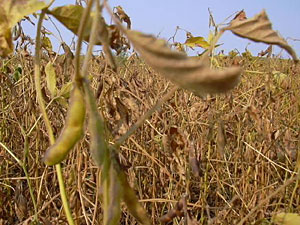|
Audio
Photos
More from MPR
|
August 2, 2005
 |
| Farmers in southern Minnesota have not had nearly enough rain this growing season, and their corn and soybean crops are suffering. (MPR file photo) |
Sioux Falls, S.D. — Most farmers aren't going to see record corn and soybean yields this year in Minnesota. While many fields look good, for others, Mother Nature will be to blame come harvest time.
Last week, farmers in southern Minnesota received a good soaking rain. But for many it may have come too late.
Giles Randall, a soil scientist for the University of Minnesota Extension Service in Waseca, monitors the area from Worthington to Hutchinson to Rochester. Randall says what last week's rain did was take away the extremes.
Before the rain, some fields were showing extreme drought conditions. Randall says there were areas that were three to five inches below normal, and now that's changed.
"I think we tend to see more of the general patterns, from the generally dry, to very adequate, to other areas that would be generally too wet," says Randall.
Randall says farmers in southern Minnesota need four inches of rain in August, and another three in September, to maintain the crop they have now. He says for years producers have had record-breaking yields.
But there really isn't a normal crop yield to measure from. Randall says production has increased nearly two bushels an acre each year for 30 years. But he says that has more to do with technology than with timely rains.
"The improved genetics, and the management of the herbicides that allow us to control weeds, the planters that allow us to do things right" have increased farmers' yields, says Randall, "as long as Mother Nature cooperates."
But Mother Nature isn't cooperating in northwestern Minnesota, where the problem is just the opposite -- too much rain. Officials in Kittson and Roseau counties are looking for a federal disaster declaration for farmers.
Nathan Johnson, regional director of the Farm Service Agency in Roseau, says farmers were optimistic in April when planting began. But their hopes were quickly dashed. Johnson says it started raining in May, and it hasn't really stopped.
"Kittson County had 50 percent of unplanted acres to begin with, and probably they'll harvest half a crop of what did get planted in small grains and sugar beets. Soybeans are way behind schedule and that'll be short, so there won't be much of a crop in Kittson County," says Johnson. "Roseau County is pretty similar. They got a few more acres planted, but of the stuff that did get planted, it's not going to be a very good production year."
What that means to farmers is only 10 percent of the crop they saw last year. Johnson says many farmers are deciding if they can survive another year, or if they should get out now.
"I hope every producer that has a desire to continue farming could work through this," says Johnson. "But when you do not get yields, and you already have the expense of fertilizer that was put out there this spring and those kinds of things, you keep the ground black and you knock down weeds and you're spraying -- they've got expenses without any income."
Johnson says federal crop insurance isn't enough to cover expenses. He says 97 percent of farmers in Kittson County have the insurance. But they also have to pay land rents and machinery payments -- expenses not covered under crop insurance.
Kittson County Extension Agent Kelly Turgeon estimates the gross crop loss at $142 million. Turgeon says the loss of income will hurt main street businesses just as hard as producers.
Minnesota officials have asked for a federal disaster declaration for the northern counties. Assistance would come in the form of low interest loans -- something most farmers don't need. But it may be the only way to get them through to another year.
Nineteen central Minnesota counties received a federal disaster declaration due to winter frost and cold spring temperatures. Alfalfa and other forage crops were the most severely affected.




